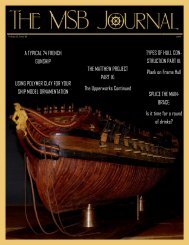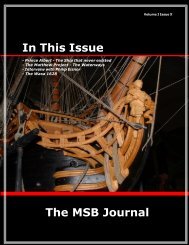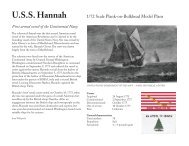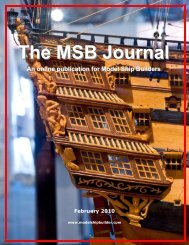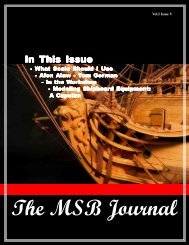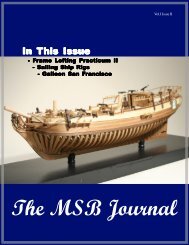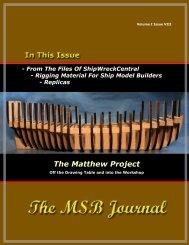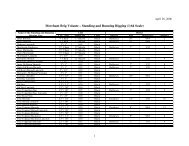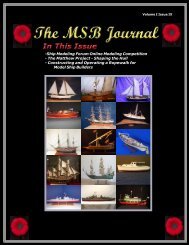Create successful ePaper yourself
Turn your PDF publications into a flip-book with our unique Google optimized e-Paper software.
TheMSB Journal<strong>August</strong> <strong>2012</strong>www.modelshipbuilder.com
Table of ContentsThe MSB JournalISSN 1913-6943<strong>August</strong> <strong>2012</strong>© www.modelshipbuilder.comAll rights reserved.Comments and opinions are that of individualauthors; The MSB Journal claimsno responsibility thereof."Published bywww.modelshipbuilder.comFighting Warship 10 Gun Brig 3Kathleen and May 4Peter Easton—Scourge of theWestern Atlantic16The Book Nook 19Historic Naval Dockyards 20On the Cover10 Gun Brig (c1825)Photo-National Maritime MuseumBadges: Heraldry of CanadianNaval <strong>Ship</strong>s22How to Contact The MSB JournalBy email: editor@msbjournal.comBy Snail-MailThe MSB Journalc/o Winston Scoville2 St. Charles Place RR5Clinton, Ontario, N0M 1L0CanadaWhat’s up at MSB? 23Wrecks of the World 25Gene’s Nautical Trivia 26Article / Content ContributionsPlease submit all article and contentcontributions to:winston@modelshipbuilder.com
3Fighting Warship, 10 Gun Brig (1825)A contemporary full hull model ofa 10-gun brig (circa 1825) builtplank on frame and fully riggedwith original masts, spars andmodern rigging. This model probablyrepresents one of the large‘Cadmus’-class of brigs built from1808 onwards, the last being‘Termagant’ of 1837. This highlydetailed model is complete with avariety of fittings such as a capstanrigged with bars, deckhatches and gratings, the largeriding bitts in the bow and a finelycarved wooden figurehead on thebeakhead. Notice also the largesquare gunports fitted with lidsthat are hinged in the middle forthe use of the short but powerfulcarronades.Overall model Dimensions: 1560mm x2035mm x 660 mmSource: National Maritime Museum,Greenwich, Englandwww.modelshipbuilder.com
4Kathleen and MayThe Last 3 Masted Topsail Schooner Still Sailing in UK WatersA quick history by Alan J McKendrickMerchant SchoonersMY INTEREST IN THESE WAS PIQUED when I moved toFylde coast in Lancashire. On one side I have LythamSt Annes, a small town, and on the other Freckleton,a village. However, both supported boatyards (smallyards for pleasure craft still exist there) and have in the19 th /early 20 th Century built many vessels, including sailingvessels up to 3 masted square rigged. Unfortunately,it’s proving a task to track down documented history onthese, especially with photos. The reason for this, itwould appear, is that this ship building was so commonplace as not being worthy of note (similar to today’s supermarket.Take away TV advertising and in 100 yearswould you expect a documented history of these?). Anyway,there are some excellent reference books on thesubject as a whole, with bits of reference to these particularlocalities.Think of the infrastructure at that period. Roads were forthe most part dirt tracks. The railways and canals joinedpoints of manufacture to large towns and cities withlarge docks for the import of raw materials and the exportof goods to the colonies and the rest of the world.So there was a huge area of the country not served by asystem of easy access for buying and selling of these goods. Hence the coastal tradingvessel way of life developed, transporting small quantities of goods around the country asrequired, for onward journey by mule and cart.These vessels were built in most small coastal towns, sometimes by just one family. Somewere built on the Eastern Seaboard of the USA and Canada (lots of wood) and then sailedacross the Pond.There were many variations of the basic pattern (a lot were built without drawings, and tocope with a peculiarity of local waters). However, they all had long flat sections to providecargo carrying space, and a flatish bottom so they could be laid on the ground either on abeach, or at a jetty on an estuary, at flood tide, would stay upright at ebb tide to enablethem to be offloaded/ loaded and refloated as the tide flooded.Torridge EstuaryTHIS AREA IS FAMOUS FOR ITS SHIPBUILDING THROUGHOUT HISTORY, notably in the towns of Appledore,Bideford, and Barnstaple with Appledore being noted for its Merchant Schoonersand is constantly mentioned in reference books.www.modelshipbuilder.com
5In the mediaeval and early modern periods this would have been carried out on the foreshoreas was usual at that time, but by the 19 th Century purpose built shipyards were comingin to use. The area also supplied ships and sailors which played a big part in the defeatof the Spanish Armada. In the 16 thCentury, Bideford was Britain's thirdlargest port.Local merchants also imported vastquantities of wool during the reign ofCharles I and had so great a share ofthe trade with Newfoundland that, in1699, they sent out more ships thanany other in England apart from Londonand Topsham.More recently the yards specialised inbuilding full sized replicas and thesehave included Viking Longships, RomanGalleys and Sir Frances Drake’sGolden Hind.Figure 1: - A hulk on the Torridge EstuarySadly, that industry is now in declineand the major ship building at Appledorehas now come to an end but there is still plenty of activity there.Basically, it’s a whole area of history that has been forgotten, although there is a lot of archaeologicalevidence in the shape of hulks half buried, rotted away in estuaries, an exampleis shown in Figure 1.The Kathleen and MayFIRST HEARD OF THE KATHLEEN AND MAY EARLY IN 2010 when the European Association of Bottleships(of which I am a member) decided to hold it’s biannual convention in Barnstaple,Devonshire. This was also to include a day on the Kathleen and May, moored inI Bideford, (pronounced ‘Biddyford’)a short journey from Barnstaple,(Barns-tap-l) with a display of Bottleshipsand demonstrations for the public.The map below in Figure 2 showsthe locations of these two towns onthe Torridge Estuary. I’ve also shownAppledore, mentioned above, and Iwas looking forward to attending tosee the areas I had read about.It is tradition at these conventionsthat they are held a maritime locationwith historical ship to visit – the shipbecomes the subject of a competitionfor the best <strong>Ship</strong> in a Bottle model ofit. Hence, I set about research on theFigure 2- Barnstaple, Bidefordand Appledore, Devonshirewww.modelshipbuilder.com
6Kathleen and May.As it happened, events conspired to prevent me attending the convention as well as havingto put the competition attempt on the back burner. A couple of weeks ago I took myself offto the Liverpool Maritime Museum (heavy on the Titanic and the slave trade to the exclusionof other things – a personal view) and you can imagine my delight to find the Kathleenand May moored alongside in the basin. It wasn’t open to visitors, but I did manage toget a number of photos, even if it was a dull day.The Kathleen and MayThe Kathleen and May, later to become famous as the last merchant schooner registeredat a home port in the United Kingdom to earn her living at sea carrying cargoes, was builtat Ferguson and Baird’s yard at Connah’s Quay, Flintshire, Wales, on the River Dee, nearthe border with England (close to Chester), for Captain John Coppack of Coppack Bros. andCo., one of the town’s leading ship owners, and was launched in April 1900, and at thattime, was named ‘Lizzie May’ after the Captain’s two daughters.She cost £2,700, is a three-masted topsail schooner of 136 tons gross (99 tons net), witha registered length of just under 100 feet, breadth of 23, feet and a hold 10 feet deep.She could carry about 250 tons of cargo.Planked with 3 inch thick seasoned pitch pine, laid on heavy doubled frames of oak andfastened with treenails and iron bolts. She was employed in the general coasting trade andin her first 8 years she sailed nearly 40,000 miles, carrying such bulk cargoes as coal,china clay, cement, bricks, fertilisers and various cargoes of over 24,000 tons total fromOban (West Coast of Scotland) to the Channel Islands, London and Ireland.In 1908 she was purchased by Martin J Fleming of Youghal in the Irish Republic, registeredat Cork, and renamed the Kathleen and May after his daughters. She became part of theowner’s fleet of coal ships, trading between the Bristol Channel ports and Youghal for over20 years.The schooner had been built with all three topsail yards of almost the same size, but hernew owner added a longer lower yard sometime before the First World War. At a later datea martingale was fitted to the bowsprit but this was removed in 1947.The original reefing gear fitted was the first known example of Appledore roller reefing, thesail being reefed by a ratchet lever that engaged the cogs on the gaff boom thereby windingthe sail around it and then locked to prevent the sail unwinding from the boom. Thishas all now been fully restored. She also was fitted to unload in small harbours with nocranes.In 1931 she was sold again to Captain William Jewell of Appledore in North Devon, whowas in partnership with his son Captain Tommy Jewell. The trip to her new home was to beher last journey under sail alone. She was given a refit, and her yards, except for the foreyard,were sent down and she was fitted with a semi-diesel engine. She sailed in the Irishtrade. She also carried coal from Mersey to the south coast and she continued trading rightthrough the war. A new engine was fitted, her hatches were enlarged and her masts poledoff to give her an efficient and handsome sail plan as a motor vessel with sail assist.In 1945 William Jewell died and the schooner was left to his son Tommy, who continuedwww.modelshipbuilder.com
7the commercial success of the Kathleen and May. In 1960 he retired the Kathleen & Mayfrom active service.During 1968, the Kathleen and May was discovered in bad repair by the Duke of Edinburghwho created the Maritime Trust in London to help preserve her, and was bought by them in1970. They began restoring her as a typical West Country schooner, as she was the onlyremaining example of these trading schooners. After the Maritime Trust failed to secure a£2 million lottery bid, Mr Steve Clarke from Bideford in Devon bought her in 1998. She wastowed back to Bideford and moored at a disused coal wharf where restoration work began.Restoration required more than 60 tons of oak, 3500 feet of larch planking, and tropicalhardwood decking.Kathleen and May is now based in Liverpool, and has just passed her 5 year out of waterMCA inspection with 100% compliancy, with the invaluable help of all the volunteers alongwith the amazing gift of the dry dock and a lot of help from that the Cammell Laird <strong>Ship</strong>Yard kindly donated to her.She was moored at the head of the Avenueof Sail for HM the Queen's Diamond Jubileeon the opposite bank to the Royal Barge.From there she sails to the Brest 4 year InternationalFestival where she is one of 12ships sponsored by the French Governmentout of the two and a half thousand ships thatwill be there.She will be expected back in Liverpoolaround the 24th of July.General Facts and FiguresFunction:Cargo VesselType:Topsail SchoonerLength Overall:98.30 feetGross Cargo Tonnage: 250.00Net Tonnage: 99.00Depth Hold:10.16 feetMaximum Breadth: 23.15 feet<strong>Builder</strong>:1900, Ferguson andBaird,Connah's QuayLocation:LiverpoolCurrent use:Private / OperatingFigure 3 shows a basic sketch of the sail layout of a Topsail schooner, and Figure 4 showsthe lines of a schooner very similar to the Kathleen and May.7246111358910Figure 3: - Sketch of Sail and Basic Riggingwww.modelshipbuilder.com
8Mizzen mast Main mast Foremast1. Mizzen Sail 3. Main Sail 5. Foresail2. Mizzen Gaff Topsail 4. Main Gaff Topsail 6. Topsail7. Topgallant Sail8. Fore Staysail9. Inner Jib10. Jib11. Flying JibFigure 4: Lines of a schooner very similar to Kathleen and MayI’ve deliberately shied away from copying and pasting photos from the web owing to possiblecopyright, however here’s the Kathleen and May’s website is http://www.kathleenandmay.co.uk/ so you can have a look. My own photos are below – no problemusing these. Some were taken through a window from inside the museum – its not oftenone is on a level with the top of a mast.www.modelshipbuilder.com
9www.modelshipbuilder.com
10www.modelshipbuilder.com
11www.modelshipbuilder.com
12www.modelshipbuilder.com
13www.modelshipbuilder.com
14www.modelshipbuilder.com
15The Bomb VesselCross Section <strong>Model</strong>An exclusive <strong>Model</strong> <strong>Ship</strong> <strong>Builder</strong><strong>Model</strong>ing Project“...This is the finest set ofdrawings I ever worked with!“Mike. Rohrer—Proto-type builder“These drawings are amazing! I’mlooking forward to building thismodel“Daniel Richardson—USA“Extremely detailed plans for a model. I have tosay, I’m very impressed. Great Job!“Alfred Anderson—U.K.“Plans arrived today… They far exceeded myexpectations… Thank you!Tristan Rockstrom—CanadaPlans Available at the <strong>Model</strong> <strong>Ship</strong> <strong>Builder</strong> web site!A 1:24 scale model based on Peter Goodwins “Anatomy of the <strong>Ship</strong>—Bomb VesselGranado and original Bomb Vessel drawings by Thomas Slade.Contains 63 pages of detailed drawings and templates of every part of the model.Numerous 3-dimensional constructional drawings provide you all the informationyou need to know to build this model. As well, it is supported by an online forumwhere you can ask questions, view other builds as they occur and even displayyour build if you wish.All pages are printed on 11” x 17” stock.Plans: $57.50 CND set + <strong>Ship</strong>ping/HandlingAvailable at www.modelshipbuilder.comHelp support the MSB Journal and get your set todaywww.modelshipbuilder.com
16Peter EastonScourge of the Western AtlanticOf the various pirates who lurked along thewild, sparsely inhabited coasts of Newfoundlandin the 16th and 17th centuries, PeterEaston was among the elite, most successfuland best known. His plundering, which rangedfrom Newfoundland and the Grand Banks southto the Caribbean and Spanish Main, made himthe scourge of the Western Atlantic for morethan a decade.Easton was born of an old and respectable Englishfamily and grew up to serve in Queen ElizabethI's navy as a privateer. In 1602 on hisway to Newfoundland escorting an English fishingconvoy, Easton captured a Dutch pirateship and found she carried prisoners from anIrish ship sunk by the Dutchmen. Among themwas the daughter of the King of Connaught, ayoung lady named Sheila. Legend has it thatPrincess Sheila married Easton's top lieutenant,Gilbert Pike, and on arriving in Newfoundlandthe couple settled at Mosquito, now known as Bristol's Hope on the western shore ofConception Bay. When Easton returned to England, he found that Queen Elizabeth had diedand her successor,King James I, haddisbanded the navy.So the privateer decidedto become apirate, preying onmerchant ships plyingthe western approachesto the EnglishChannel.1NewfoundlandHis fleet was said tonumber 40 vesselsby the time the kingbowed to pressurefrom Easton's victimsand sent a squadronunder a young captainHenry Mainwarring(who later alsoturned to piracy) toput a stop to theplundering. Tippedoff to this, Eastontook his ten best21. Harbour Grace2. Kellys Islandwww.modelshipbuilder.com
17ships and crews and fled to Newfoundland,settling at HarbourGrace, just south of Mosquito. Therehe built a fort and settled down tosome serious raiding.He demanded paid tributes fromfishing vessels on the Grand Banks,and built a flourishing trade in capturedships and goods. Among thefishing vessels and shore settlementsEaston found a ready sourceof capable, and often quite willing,crewmen for his fleet.Not only did the pirate fortify HarbourGrace, the late Newfoundlandauthor Harold Horwood claimsEaston also set up another base atKelly's Island on the far shore ofLegend claims 47 pirates are buried in the oldSt. Paul’s Church graveyard in Harbour GraceConception Bay, a place that abounds with lore of buried treasure and is said to even havebeen named after another pirate who was based there.The Spanish colonies of the Caribbean and their treasure galleons were Easton's favouritevictims. He was sailing the San Sebastian, one of the richest prizes ever captured by a pirate,back to his Newfoundland headquarters in September, 1611, when he was forced todeal with another of his adversaries.<strong>Ship</strong>s protecting the French and Basque fishing fleets, in Easton's absence, had raided andcaptured his fort at Harbour Grace. When they spotted the pirate's fleet entering ConceptionBay an intercepting squadron put out from the harbour and the battle was on. Withdaring and skill, Easton's fleet defeated the Basques and wrecked their flagship St. Malo ona tiny islet outside the harbour, then they landed and re-captured their fort. It is said that47 of Easton's crew who died that day nearly 400 years ago are buried in a graveyard atBear Cove near the mouth of Harbour Grace. Easton's prize, the San Sebastian, eventuallywas thoroughly looted of treasure then burned and set adrift to ground further up the harbourwhere her bones may today still lie buried in the bottom.With this sort of success, Peter Easton became a legend along the shores of Newfoundland.The first official English colony on the island, at Cupids a few miles south of Easton's lair,came to depend on the pirate for protection from raiding Basques and others. But Easton,perhaps still loyal to the crown, began making overtures to King James for a pardon. Havingcaptured the "admiral" of the English fishing fleet, Captain Richard Whitbourne, andkept him prisoner for 11 weeks, Easton released him on condition Whitbourne would petitionthe King for his pardon. This was eventually given and is documented in British records.In the meantime, Easton decided to move his headquarters to Ferryland which faces theopen Atlantic on the southern shore of the Avalon Peninsula. The pirate fortified the smallharbour and continued to terrorize the shipping lanes until 1614. Easton left Newfoundland,presumably with his vast store of loot, and set off with his ships for the Azores tocapture another Spanish treasure fleet. His success there led to alliances on the easternwww.modelshipbuilder.com
18side of the Atlantic which enabled Easton to amass an even greater fortune. He eventuallyretired from piracy as one of the world's wealthiest men, settling in Italy and purchasing apeerage as the Marquis of Savoy.Today in Harbour Grace, thequaint old customs house is builton what is believed the site of PeterEaston's fort (later occupied byMainwarring). The building housesa museum which devotes an entireroom to the legendary pirate admiraland includes models of whathis fort and one of his ships,Happy Adventure, are believed tohave looked like. Easton and hismen also left other legacies inNewfoundland.His lieutenant Gilbert Pike and hiswife Princess Sheila, again accordingto author Horwood, sired whatbecame one of the oldest and largestfamilies in Canada. Across theOld Customs House, today a museum believed to be built on thesite of Peter Easton’s fort.bay in Kelligrews (named after the powerful family that originally sponsored Easton's piracyin southwestern England), some of his men remained and adopted their leader's surnamewhen he left Newfoundland. Horwood claims their descendants can still be found inthe area.www.modelshipbuilder.com
19The Book NookBooks of interest for the <strong>Model</strong> <strong>Ship</strong> <strong>Builder</strong>Shortly before the launch of the reconstructedGreek warship, Olympias, the firstedition of The Athenian Trireme was published,providing historical and technicalbackground to the reconstruction of theship. Since then, five seasons of experimentaltrials have been conducted on theship under oar and sail, and the lessonslearned have been supplemented by newarchaeological discoveries and by historical,scientific and physiological research overthe past fifteen years. For this second edition,the text has been recast and a numberof substantive changes have beenmade. In addition, there is an entirely newchapter that describes the trials of Olympiasin detail, reports the performance figures,and outlines the changes desirable inany second reconstruction. There are nineteennew illustrations, including elevenphotographs of Olympias at sea demonstratingfeatures of the design that couldbe represented only by drawings in the firstedition.The Athenian Trireme: TheHistory and Reconstruction ofan Ancient Greek Warship byJ.F. Coates, R.B. RankovISBN-10: 0521564565ISBN-13: 0521564564Cambridge Univeristy PressGet your copy atThe <strong>Model</strong> <strong>Ship</strong> <strong>Builder</strong> Book Storewww.modelshipbuilder.com
20Historic Naval DockyardsKingston Royal Naval DockyardThe Kingston Royal Naval Dockyard was a Royal Navy Dockyard from 1788 to 1853 inKingston, Ontario, Canada, at the site of the current Royal Military College of Canada.A government wharf was constructed in 1783 on the eastern side of Lake Ontario by MajorJohn Ross of the 34th Regiment. When the Provincial Marine relocated from Carleton Islandto Kingston, Point Frederick was established as a naval depot in 1789. The quarter-mastergeneral`sdepartment of the army, who had a monopoly on shipping on the Great Lakes,built transport schooners for the Provincial Marine at Point Frederick by 1792. In 1809 aheavily-armed, three-masted square-rigged vessel, `HMS Royal George (1809)` was builtand launched in Navy Bay specifically for fighting on the lakes.Kingston Royal Naval Dockyard was the only Royal Navy base on Lake Ontario, counteringthe American naval base a short distance away in Sackets Harbour, New York during theWar of 1812. During the War of 1812 attacks were launched from the dockyard on theAmerican bases at Sackets Harbour, and Oswego. On 10 November 1812, at the beginningof the War of 1812, the Americans pursued `HMS Royal George (1809)` into Kingston harbourand were held off by the shore batteries.Commanded by Commodore Sir James Lucas Yeo, the Royal Navy took over operations onthe Great Lakes from the Provincial Marine in 1813. A stone building, built around 1813,was used as a naval hospital during the War of 1812 and is now known as the Ordnancestorekeeper`s quarters. After the Rush-Bagot Treaty of 1817, the role of the dockyard di-www.modelshipbuilder.com
21minished. A blacksmithshop, which was built inthe dockyard in 1823 isnow used by the RoyalMilitary College of Canada.Half of the Royalartificer`s cottages,which were built in1822, were destroyed bya fire in the 1880s.Naval shipyard, Point Frederick, July 1815. Watercolour by Emeric Essex Vidal.Commodore's house and two ships under construction, the Canada and theWolfe, can be seen in the backgroundThe War of 1812 hasbeen known as the shipbuilderswar. <strong>Ship</strong>s werebuilt on Point Frederickby the successive commissionersof the dockyard,Captain RichardO`Conor and Sir RobertHall. Under the terms ofthe Rush-Bagot agreementof 1817, naval forces on Lake Ontario were restricted to one gunboat. Nevertheless,Sir Robert Hall maintained the ships of the fleet in ordinary until his death in 1818. His replacement,Captain Robert Barrie built a Stone Frigate to warehouse the gear and riggingfrom the ships, which were dismantled and housed in Navy Bay. After the wood barracksburned down in 1816, the Stone Frigate became the main building on Point Frederick. CaptainRobert Barrie was recalled and the war ships, which were by the early 1830s merelyhulks, were auctioned off.Closed in 1835, the dockyard reopened in 1837 in response to rebellions in the Canadas.Captain Williams Sandom and a party of sailors resided in the Stone Frigate warehouseclose to the St. Lawrence pier in Navy Bay. Their headquarters was the HMS Niagara, oneof the 1812 hulks which had been repurchased. Steamships were hired to transport regularsand militia from Kingston at the Battle of the Windmill, near Prescott. Steam warshipsoperated from the dockyard. An old wooden blockhouse protected the battery at the end ofPoint Frederick. Four stone Martello towers were built along the shore to defend Kingston'sharbour after the Oregon Crisis. One of the towers, known as Fort Frederick was built byRoyal Engineers on Point Frederick near the old dockyard. The dockyard closed in 1853.A wooden commodore`s house, which was shown on a plan dated 1868-70, was stillstanding when the Royal Military College of Canada opened in the 1876. By the 1860s,only the Stone Frigate storehouse and one wharf were kept in repair. The old hulks of theWar of 1812 were hard aground in the mud and broken by the annual freezing and thawingof Navy Bay and Deadman Bay.The ordnance and admiralty lands in Kingston, which included the dockyard on Point Frederick,were transferred to the Canadian government on the condition it should not beused for anything but naval purposes. An order in council ratified the agreement addingthe phrase and for the naval defence of Canada.The site was designated a National Historic Site of Canada in 1928.www.modelshipbuilder.com
22Badges:Heraldry of Canadian Naval <strong>Ship</strong>sHMCS SiouxHMCS SiouxBlazon: Argent, a Sioux Indian head proper facing the dexter and wearingan appropriate feather head-dress of a Sioux ChiefColours: White and VermillionMotto: Then I will fightHMCS Sioux (R64) was a V class destroyer of the Royal Canadian Navy that saw service in World WarII.She was launched as HMS Vixen for the British Royal Navy. She was transferred to the Royal CanadianNavy, into which she was then commissioned 21 February 1944 while fitting out, and was completedon 5 March 1944.Sioux was based with the British Home Fleet at Scapa Flow. Her duties involved escorting convoys toRussia (RA-58/JW-58 in April 1944); raids on German coastal shipping off the coast of Norway; andattempts to sink the German battleship Tirpitz, which was anchored at Altenfjord, Norway. On D-Day, Sioux provided naval gunfire off Juno Beach. In February 1945, after escorting convoy JW-64 toPolyarnoe; she was sent from there as part of a relief expedition to convey 500 inhabitants of a Norwegianisland, left without food or fishing boats by the Germans, to safety. On 17 February 1945,she returned with convoy RA-64, fighting both determined JU-88 attacks and Arctic gales, and sailedto Halifax immediately thereafter, to prepare for transfer to the British Pacific Fleet and operationsagainst Japan.She wore pennant R64 until she was paid off into reserve shortly after the war. She emerged again,fully modernized, in 1950, to participate in the Korean War. She helped provide naval support for thetroops that landed at Inchon in September 1950, the first entry of Canadian forces in the war.She wore pennant 225 until she was finally paid off in October 1963.www.modelshipbuilder.com
23What’s Up at MSB?It being the summer here when models generally get put up on the shelf, thanks to thereach of the internet you’d never know it with the various projects that are on the go atthe <strong>Model</strong> <strong>Ship</strong> <strong>Builder</strong> website.Thanks to Arthur (aew) there is a new scale converter available for download from the Resourcessection.A new project, the Helen MacLeod II is now under way.This project is based on restoration project underway inBayfield, Ontario, Canada, by the Bayfield Historical Society.They are restoring what is believed to be the last existingsailing workboat from the Great Lakes. A smallgroup of the site members has taken on the project ofbuilding a scaled model of the boat. Should prove to be avery interesting project being that the model is based onan actual boat.You can check out the project progress here: Helen MacLeod II Project ForumThere are two modeling projects based on War of 1812 ships (HMS Ontario and HMS RoyalGeorge) also in the drafting stages. Anyone interested in seeing modeling plans being developedwill find these very interesting. To follow along: HMS Ontario Forum, HMS RoyalGeorge Forum.HMS Royal GeorgeHMS Ontariowww.modelshipbuilder.com
24Anyone who has been at the site for a while have probably been followingmember RicksbuildII’s build of the Bluenose. A little over twoyears after staring his build log Rick posted some final pictures of themodel. Great show Rick.You can check out RicksbuildII at his build logSite member aew (Arthur) updated his build log of his first POBbuild (Mantua’s Astrolab). His original build log was posted at thenow defunct Drydockmodels forum. This appears to be a great jobfor a first!You can check out aew's build log.Mike41 has completed his scratch build in the Navy Board style ofthe HMS Pandora. Nicely done Mike.Check out Mike’s build log. Lots of info there.Another interesting build log at the site is member Norman Valentine’sscratch build of the Jhelum (1849). After driving past thehulk of the ship for 4 years, Norman decided he was eventually goingto build a model of the ship. Having found some time to getstart you can follow along with him in his build log.Gene Bodnar is moving along with his 1:144 scale model of the Titanic.He’s making amazing progress on this model having startedin February. Especially considering he has completed two othermodel since he started. You can check out his build log.I’ll try to keep you updated every issue with what’s happening atthe MSB site. I’d like to try to cover everything, but I suspect thatwill be near impossible as time goes on and we get busier. So, forthose who do not see updates on your particular project here, it’scertainly nothing personal. It’s merely a matter of time constraints.Hope to see you at the site!!!www.modelshipbuilder.com
25Wrecks ofThe WorldThe MelmerbyOn or about October 1, 1890 approximatelyfive days after leavingQuebec with a cargo of timberMELMERBY began to encountersevere weather. In spite of workingthe pumps, MELMERBY was indanger of foundering. The orderwas given to jettison the deckload. Before the crew could accomplishthis, the timber got outof control and smashed three ofthe four lifeboats. On the eighthday the schooner MARY happenedupon MELMERBY and the vessel'sCaptain came aboard to attemptto guide the vessel to Pictou.Shortly thereafter another stormMelmerby Wreck 1890overtook both vessels and MARYbecame separated from MEL-MERBY. MELMERBY was demastedand driven onshore nearNew Glasgow, Nova Scotia. Sixteenmen boarded the remaininglifeboat and made for shore. Theboat overturned and all but oneperson perished. Locals who hadgathered onshore formed a humanchain and managed to reachthe one survivor in the water.Two days later two of the sixcrew remaining on MELMERBYdecided to swim for shore. Againa human chain of onlookershelped to pull them from the water.The MELMERBY's lifeboat wasMelmerby Beach, today a popular tourist destinationrepaired and used to rescue the remaining four aboard, including the captain of MARY. Thewreck remained visible long enough for the beach to be named after MELMERBY.www.modelshipbuilder.com
26Gene’s Nautical TriviaMasts1 2345 67www.modelshipbuilder.com
27Rigging Quiz1. _______________ Piece of leather-covered rope used to fasten a yard orgaff around a mast or topmast.2. _______________ Wooden bollard on a ship’s deck used to secure ropes.3. _______________ Running rope that is used to turn a yard along a horizontalplane.4. _______________ Rope that holds the leech of a square sail toward the bowwhen the ship is sailing by the wind.5. _______________ Thick ropes of the standing rigging that steady the maststo the sides.6. _______________ Running rope that is used to hold the clew of a sail towardthe bow.7. _______________ Soft rope used to darn the edges of sails.8. _______________ Ropes that seamen stand on while working on the yards.9. _______________ Rope that pulls the bottom corner of a sail to stern andholds the sail in right position.10._______________ Rope that secures the bowsprit to the stem.www.modelshipbuilder.com
28Commanders and Their <strong>Ship</strong>sMatch the commander in the left column with the name of his ship in the right column.1. _____ Blackbeard A. Golden HindB. Oxford2. _____ Vasco Da Gama C. VictoriaD. Queen Anne’s Revenge3. _____ Henry Hudson E. CalypsoF. Endeavor4. _____ Ferdinand Magellan G. St. GabrielH. Half Moon5. _____ Henry Hudson I. Mary CelesteJ. Morning Cloud6. _____ Captain Briggs7. _____ James Cook8. _____ Francis Drake9. _____ Edwared Heath10. _____ Jacques Cousteauwww.modelshipbuilder.com
29Gene’s Nautical Trivia AnswersANSWERS:MASTS:C R O S S T R E E SHEE N CT E N O N F O R C A PK N PS B O HI F OB H UB E NM A S T H E A DL SRIGGING QUIZ: 1-Parral, 2-Bitt, 3-Brace, 4-Bowline, 5-Shrouds, 6-Tack,7-Boltrope, 8-Footropes, 9-Sheet, and 10-Gammoning.COMMANDERS AND THEIR SHIPS: 1-D, 2-G, 3-H, 4-C, 5-B, 6-I, 7-F,8-A, 9-J, and 10-E.www.modelshipbuilder.com
30<strong>Model</strong>ing ClubsWish to have your club info displayed? Send an email to info@modelshipbuilder.comHyde Street Pier <strong>Model</strong> <strong>Ship</strong>wrightsMeet at the club's model shop aboard theEureka, Hyde Street Pier, a National ParkService historic site in San Francisco on thethird Saturday of every month @ 9:30 a.mContact: Leo KanePh: (510) 356-4226kanebulota@comcast.netTampa Bay <strong>Ship</strong> <strong>Model</strong> SocietyMeet in downtown St. Petersburg, FL on thefourth Tuesday of the month at 7:00 p.m.except December.www.tbsms.orgContact: George ShaefferGolden Triangle Marine <strong>Model</strong>ersThe club meet on the second Wednesday of eachmonth at 8:00 pm at the Albert McCormickArena, 500 Parkside Drive, Waterloo. Their mainfocus is R/C and static models. During the summerthey usually break from their Wednesdaymeetings to run their boats at the pool in front ofKitchener City Hall, plus, once a week their Saildivision travel to the pond in Wellesley to racetheir sailboats.Contact: Paul Dreher (Secretary)101 Harcourt Cres.Kitchener, OntarioN2P 1M1Ph: 519-748-0449pcadreher@sympatico.cageorgeshaeffer@gmail.comPh: (727) 798-0943Cape Ann <strong>Ship</strong> <strong>Model</strong>ers GuildMeeting at 7:00 PM the second Wednsday ofevery month at the Veterans Center, 12 EmersonAvenue, Gloucester, Massachusetts.www.casmg.orgContact: Tony Ashdontony@capeannshipmodelersguild.orgSouthwest Florida <strong>Ship</strong>modeler's GuildMeets at the - City of Bonita Springs RecreationCenter 26740 Pine Ave, Bonita Springs, FL 34135on the 2nd and 4th Saturday's each month, exceptDecember, at 0900 amContact: John WeliverPh: 239-561-5777jweliver@comcast.netPh: (978) 546-7222www.modelshipbuilder.com



